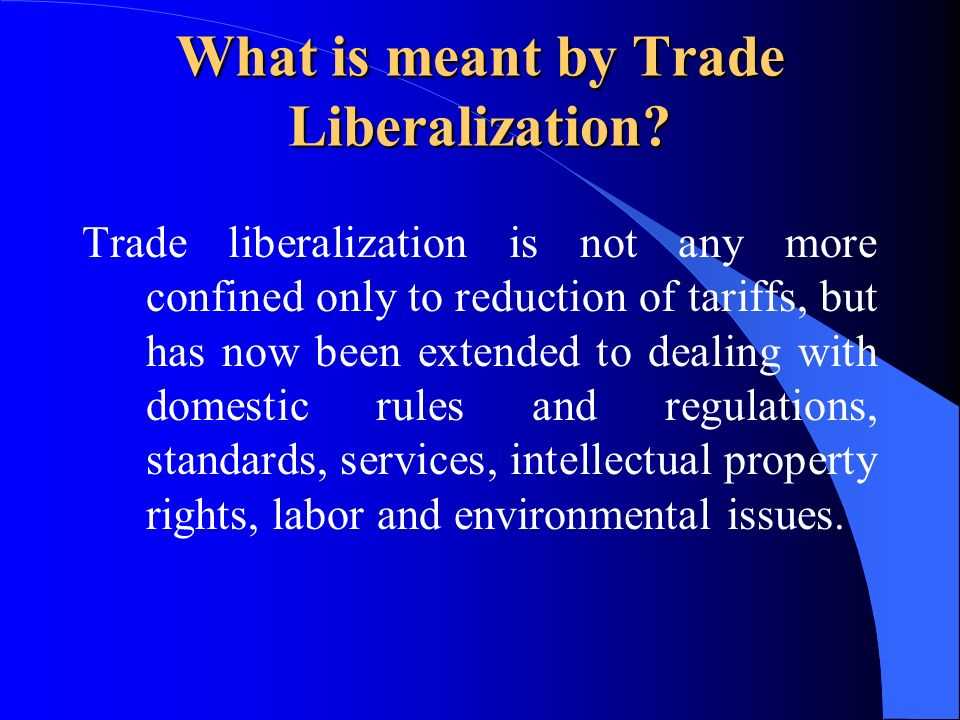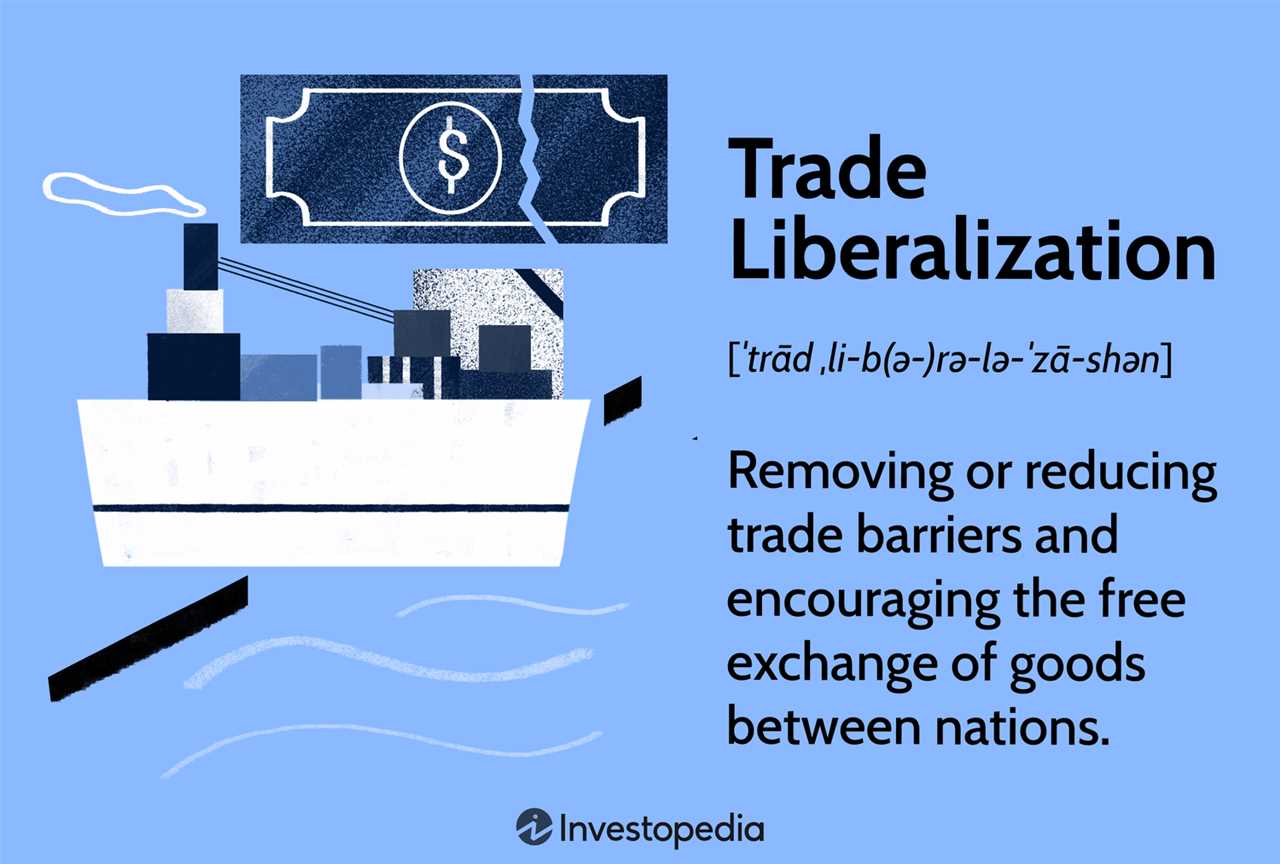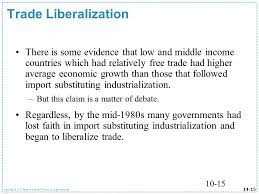What is Trade Liberalization?
Trade liberalization refers to the removal or reduction of barriers to international trade, such as tariffs, quotas, and other restrictions. It is a process that aims to promote free trade and increase economic integration between countries.
Trade liberalization is based on the principle of comparative advantage, which suggests that countries should specialize in producing goods and services in which they have a lower opportunity cost and trade with other countries for goods and services in which they have a higher opportunity cost. By allowing countries to focus on their strengths and trade with others, trade liberalization can lead to increased efficiency, productivity, and economic growth.
Mechanics of Trade Liberalization
Trade liberalization can be achieved through various mechanisms, including:
- Tariff Reduction: Countries can lower or eliminate tariffs, which are taxes imposed on imported goods. This makes imported goods cheaper and more competitive in the domestic market.
- Quota Elimination: Quotas are restrictions on the quantity of goods that can be imported. Removing quotas allows for increased imports and greater market access.
- Non-Tariff Barrier Reduction: Non-tariff barriers, such as licensing requirements, technical standards, and sanitary regulations, can also hinder trade. By reducing or eliminating these barriers, countries can facilitate trade and reduce trade costs.
- Trade Agreements: Countries can negotiate and enter into trade agreements, such as free trade agreements (FTAs) or regional trade agreements (RTAs), which aim to reduce trade barriers and promote trade between participating countries.
Overall, the mechanics of trade liberalization involve the removal or reduction of barriers that impede the flow of goods and services across borders, allowing for increased trade and economic integration.
The Mechanics of Trade Liberalization

Trade liberalization refers to the process of removing barriers and restrictions on international trade, such as tariffs, quotas, and import/export licenses. This allows for the free flow of goods and services between countries, promoting economic growth and development.
There are several key mechanisms involved in trade liberalization:
1. Tariff Reduction: One of the main components of trade liberalization is the reduction or elimination of tariffs on imported goods. Tariffs are taxes imposed on imported goods, making them more expensive and less competitive in the domestic market. By reducing tariffs, countries can lower the cost of imported goods, increase consumer choice, and promote competition.
2. Quota Elimination: Another important aspect of trade liberalization is the elimination of quotas on imports. Quotas are restrictions on the quantity of goods that can be imported into a country. By removing quotas, countries can increase the availability of imported goods, stimulate domestic industries, and enhance consumer welfare.
3. Removal of Non-Tariff Barriers: Trade liberalization also involves the removal of non-tariff barriers, such as licensing requirements, technical standards, and sanitary regulations. These barriers can create unnecessary obstacles to trade and limit market access for foreign goods and services. By eliminating these barriers, countries can facilitate trade, encourage foreign investment, and promote economic efficiency.
4. Market Access: Trade liberalization aims to improve market access for goods and services by reducing trade barriers. This allows businesses to expand their customer base and access new markets, leading to increased trade volumes and economic growth. Market access is particularly important for developing countries, as it provides opportunities for export-led growth and poverty reduction.
5. Trade Facilitation: Trade liberalization also involves measures to simplify and streamline trade procedures, such as customs clearance, documentation requirements, and border controls. These measures aim to reduce trade costs, improve efficiency, and enhance the competitiveness of businesses engaged in international trade.
Overall, trade liberalization plays a crucial role in promoting economic growth, enhancing competitiveness, and fostering global integration. By removing barriers to trade, countries can benefit from increased market access, improved consumer welfare, and greater economic opportunities.
The Benefits of Trade Liberalization

Trade liberalization refers to the removal or reduction of barriers to trade between countries. This can include the elimination of tariffs, quotas, and other trade restrictions. The goal of trade liberalization is to promote economic growth, increase efficiency, and enhance consumer welfare.
1. Economic Growth
One of the main benefits of trade liberalization is the potential for increased economic growth. When countries open up their markets to international trade, they can access a wider range of goods and services at competitive prices. This can lead to increased productivity, as firms are able to specialize in areas where they have a comparative advantage. As a result, trade liberalization can stimulate economic growth by creating new opportunities for businesses and increasing overall output.
2. Efficiency
Trade liberalization also promotes efficiency in the allocation of resources. When countries specialize in producing goods and services that they are most efficient at, they can achieve economies of scale and lower production costs. This leads to increased efficiency and productivity, as resources are allocated to their most productive uses. Additionally, trade liberalization encourages competition, which can drive firms to innovate and improve their efficiency in order to remain competitive in the global market.
3. Consumer Welfare
Trade liberalization benefits consumers by providing them with access to a wider variety of goods and services at lower prices. When trade barriers are reduced, consumers can choose from a larger selection of products, including those that may not be available domestically. This increased competition among producers can lead to lower prices and higher quality products. As a result, consumers can enjoy a higher standard of living and greater purchasing power.
Real-World Examples of Trade Liberalization
Trade liberalization refers to the removal or reduction of barriers to trade between countries, such as tariffs, quotas, and other restrictions. It aims to promote economic growth, increase competition, and enhance consumer welfare. While the concept of trade liberalization may seem abstract, there are several real-world examples that demonstrate its impact on economies and societies.
1. European Union
The European Union (EU) is a prime example of trade liberalization. The EU is a political and economic union of 27 member states, which have eliminated barriers to trade and established a single market. This means that goods, services, capital, and labor can move freely within the EU without restrictions. Trade liberalization within the EU has led to increased trade volumes, economic integration, and prosperity for member states.
2. North American Free Trade Agreement (NAFTA)
NAFTA is a trade agreement between the United States, Canada, and Mexico, which came into effect in 1994. It eliminated tariffs on most goods traded between the three countries and established rules for trade and investment. NAFTA has significantly increased trade between the member countries, boosted economic growth, and created jobs. However, it has also faced criticism for its impact on certain industries and workers.
3. ASEAN Free Trade Area (AFTA)
AFTA is a trade agreement among the member countries of the Association of Southeast Asian Nations (ASEAN). It aims to create a single market and production base in the region by eliminating tariffs and other barriers to trade. AFTA has led to increased trade and investment flows within Southeast Asia, promoting economic development and regional integration.
4. Trans-Pacific Partnership (TPP)
The TPP was a proposed trade agreement between 12 Pacific Rim countries, including the United States, Japan, Australia, and Canada. It aimed to liberalize trade and establish common rules and standards in areas such as intellectual property, labor, and the environment. Although the TPP was not ratified, its negotiations and potential impact highlighted the importance of trade liberalization in the global economy.
The Role of Government and Policy in Trade Liberalization
Trade liberalization is a complex process that involves the removal or reduction of barriers to trade, such as tariffs, quotas, and other trade restrictions. While trade liberalization can bring numerous benefits, it also requires careful management and regulation by governments and policymakers to ensure a fair and balanced playing field for all participants.
Government’s Role in Trade Liberalization

One of the key responsibilities of the government is to ensure fair competition and prevent unfair trade practices, such as dumping or subsidies that distort market prices. They may impose anti-dumping duties or countervailing duties to protect domestic industries from these practices. Additionally, the government may provide support and incentives to help domestic industries adjust to the challenges and opportunities brought about by trade liberalization.
Policies to Promote Trade Liberalization
Governments can implement various policies to promote trade liberalization and facilitate international trade. These policies include:
| Policy | Description |
|---|---|
| Tariff Reduction | Lowering or eliminating tariffs on imported goods to reduce trade barriers and encourage imports. |
| Customs Simplification | Simplifying customs procedures and documentation requirements to expedite the movement of goods across borders. |
| Trade Facilitation | Implementing measures to streamline trade processes, such as harmonizing standards and regulations, improving infrastructure, and enhancing logistics. |
| Investment Promotion | Creating a favorable investment climate to attract foreign direct investment (FDI) and stimulate economic growth. |
| Intellectual Property Rights Protection | Enforcing laws and regulations to protect intellectual property rights, fostering innovation and creativity. |
Challenges and Considerations
While trade liberalization can bring significant benefits, it also poses challenges and considerations for governments and policymakers. Some of these challenges include:
- Protecting domestic industries and workers from unfair competition
- Ensuring compliance with international trade rules and agreements
- Addressing the concerns of vulnerable sectors and communities affected by trade liberalization
- Managing the impact of trade on the environment and sustainable development
- Promoting inclusivity and equitable distribution of benefits
Therefore, governments and policymakers need to strike a balance between promoting trade liberalization and addressing these challenges. They must carefully design and implement policies that foster economic growth, protect domestic industries, and ensure social and environmental sustainability.

Emily Bibb simplifies finance through bestselling books and articles, bridging complex concepts for everyday understanding. Engaging audiences via social media, she shares insights for financial success. Active in seminars and philanthropy, Bibb aims to create a more financially informed society, driven by her passion for empowering others.
